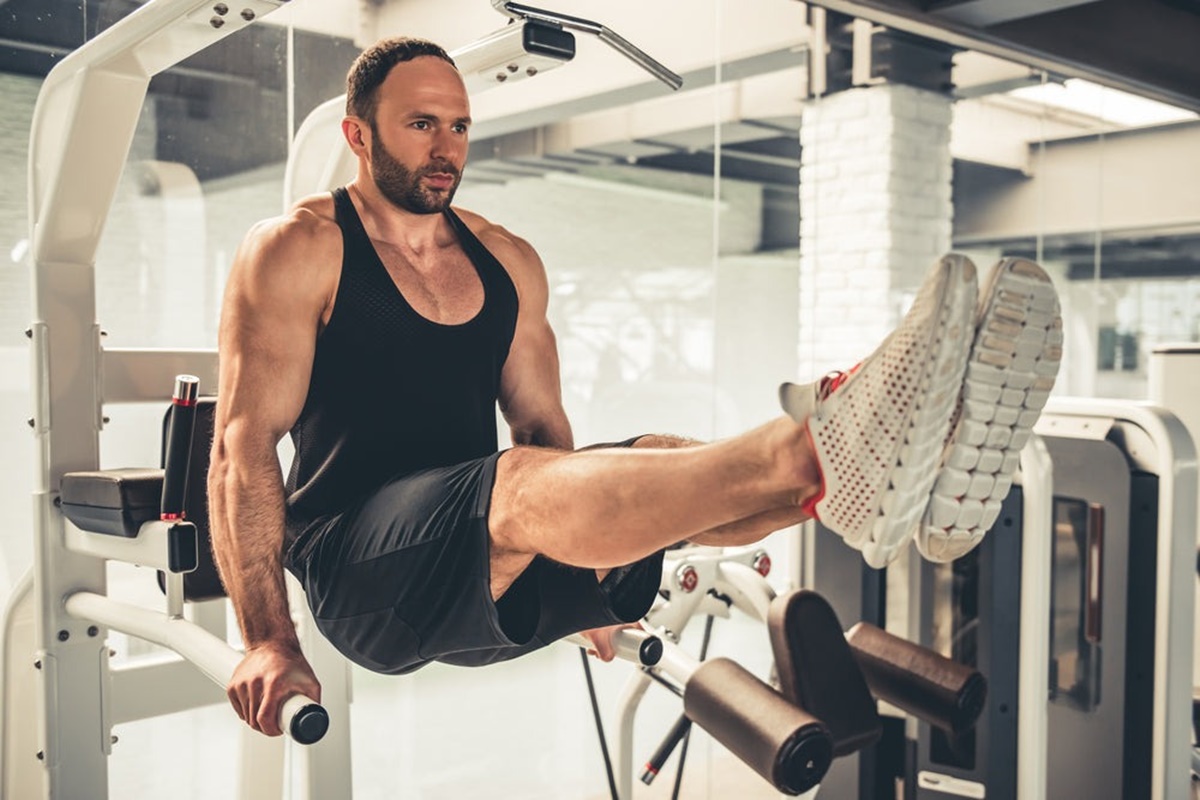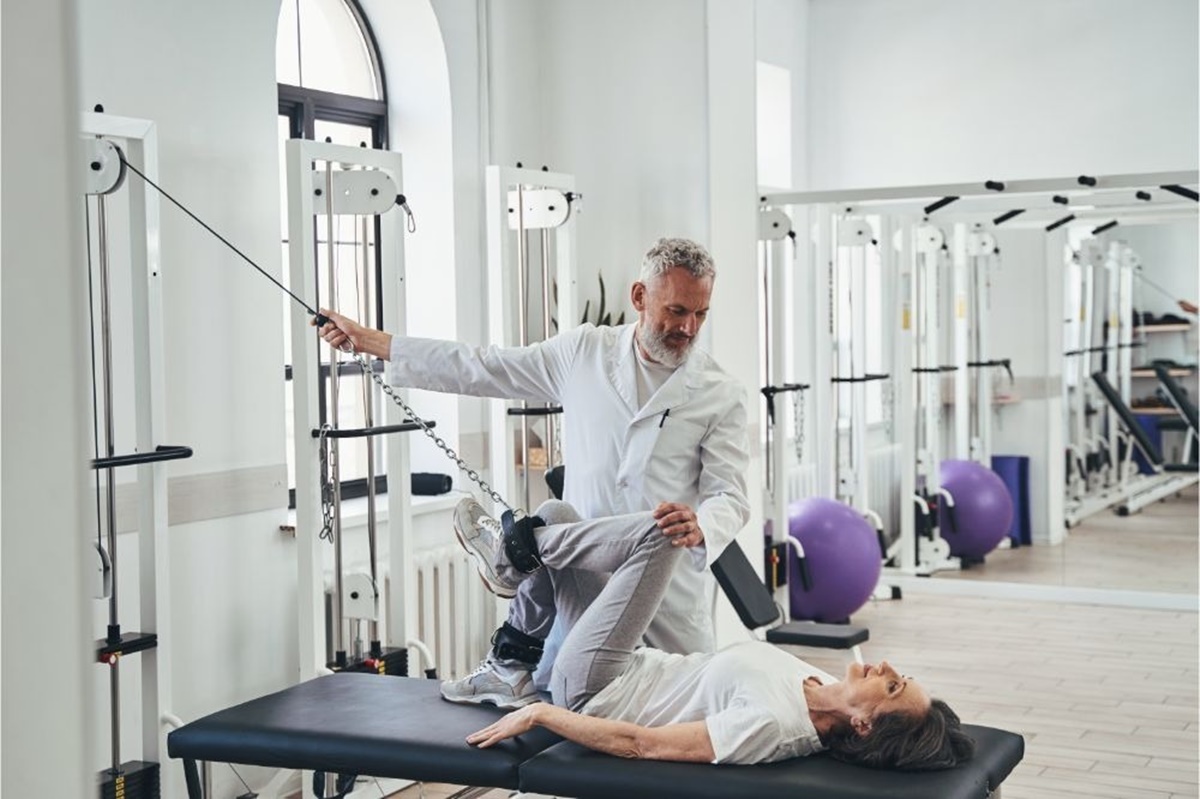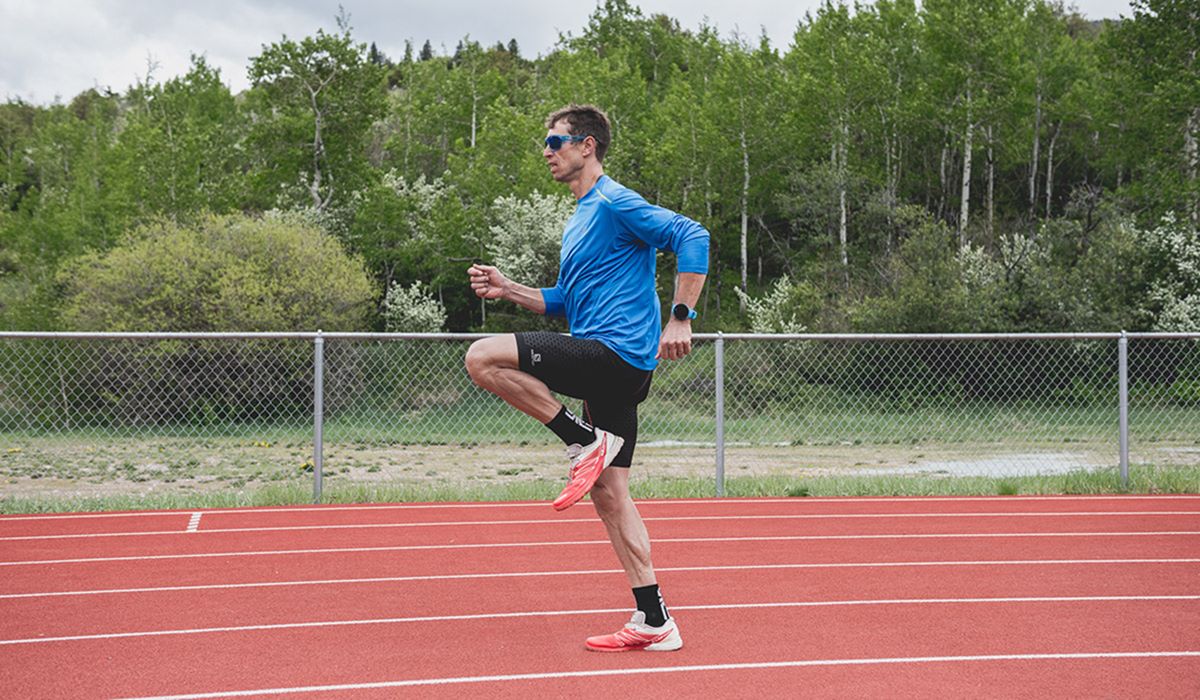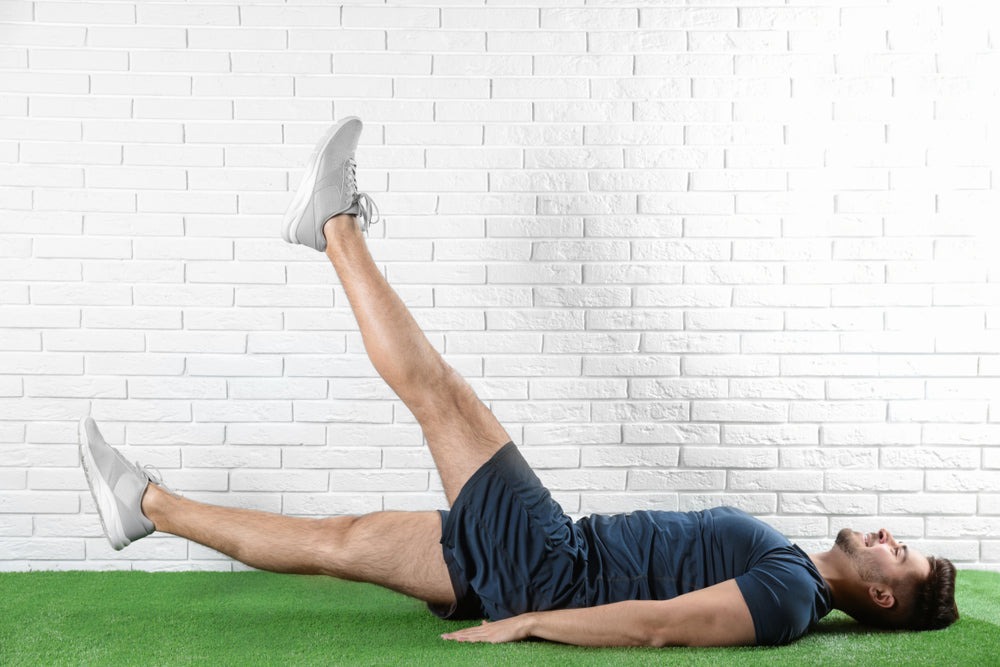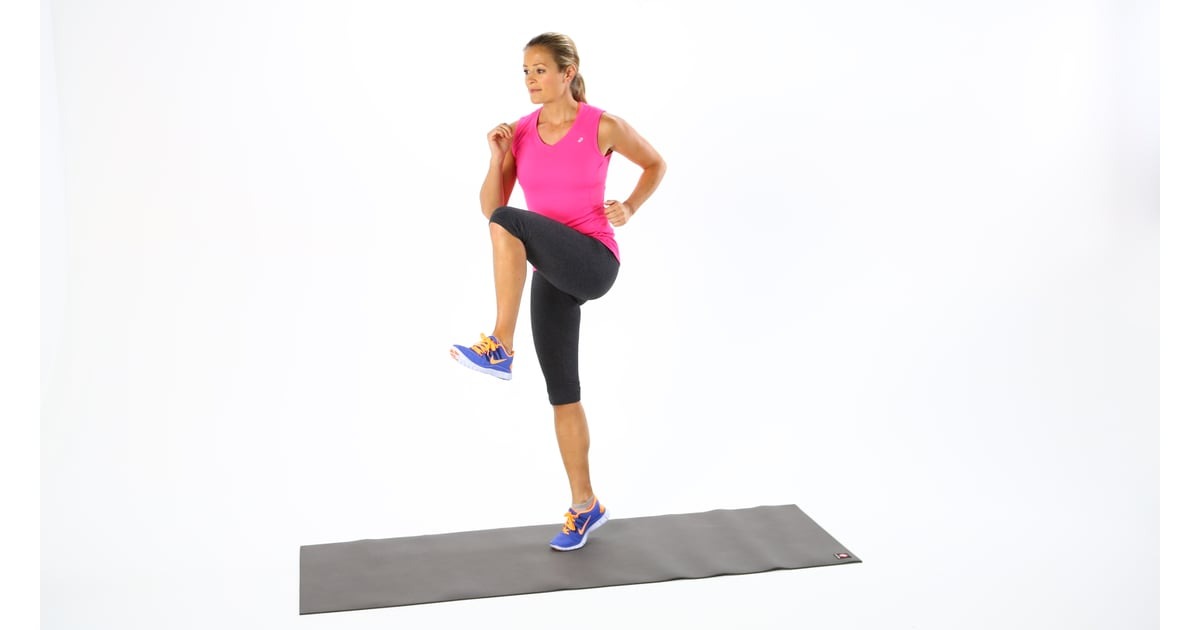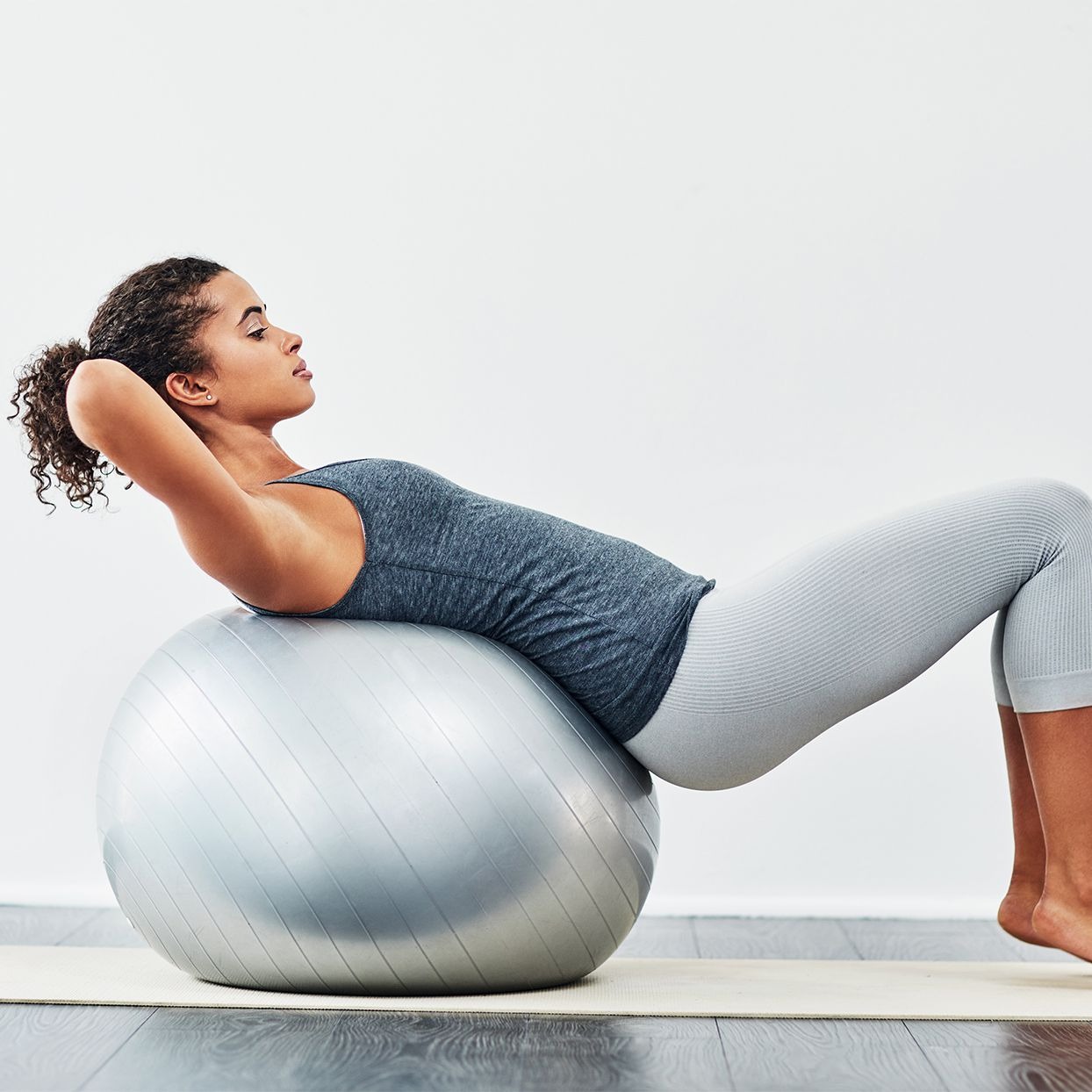

Featured
How To Exercise With A Knee Injury
Published: September 25, 2023
Learn how to exercise with a knee injury, with Featured tips to safely maintain your fitness routine and speed up recovery.
Introduction
Exercising is an essential part of maintaining a healthy lifestyle, but what happens when you’re dealing with a knee injury? Knee injuries can be frustrating and debilitating, making it challenging to engage in your regular exercise routine. However, having a knee injury does not mean you have to give up on physical activity entirely. With the right knowledge and approach, you can still exercise and stay fit while allowing your knee injury to heal.
Understanding the nature of your knee injury is crucial for developing a proper exercise plan. Every injury is unique, and treatment options can vary. It’s important to consult with a medical professional, such as a doctor or a physical therapist, to get a comprehensive understanding of your specific condition and any limitations or precautions you should take.
In this article, we will explore different types of knee injuries and the exercises that are suitable for each. We will also delve into the importance of proper technique and form, the use of supportive gear, and the significance of rest and recovery in the healing process. By following the guidelines provided, you can continue to prioritize your health and fitness while taking care of your knee injury.
Understanding Knee Injuries
Knee injuries are common and can occur due to various reasons such as sports-related activities, accidents, or even degenerative conditions like arthritis. It’s important to understand the underlying causes and mechanisms of knee injuries to effectively manage and treat them.
One of the most common knee injuries is a sprain or strain, which refers to the stretching or tearing of ligaments or muscles around the knee joint. This can happen during sudden movements, twisting, or excessive pressure on the knee. Another common knee injury is a meniscus tear, which involves the tearing of the cartilage cushioning between the thighbone (femur) and shinbone (tibia). Meniscus tears often occur during activities that involve twisting or sudden pivoting of the knee.
Patellofemoral pain syndrome is another prevalent knee condition, characterized by pain and discomfort around the front of the knee. This condition is often caused by overuse, muscle imbalances, or misalignment of the patella, commonly known as the kneecap. Additionally, knee osteoarthritis, a degenerative condition, can result in pain, inflammation, and stiffness in the knee joint.
Understanding the specific nature of your knee injury can help guide your choice of exercises and determine which activities to avoid. It is crucial to consult with a medical professional who can accurately diagnose your knee injury and provide appropriate recommendations. They may recommend further diagnostic tests such as X-rays or MRIs to assess the severity and extent of the injury.
By having a clear understanding of your knee injury, you can take the necessary precautions and make informed decisions about your exercise routine. With the right approach, you can promote healing, prevent further damage, and gradually restore strength and functionality to your injured knee.
Consulting a Medical Professional
When dealing with a knee injury, it is essential to seek guidance from a qualified medical professional. Consulting a doctor or a physical therapist who specializes in orthopedics can provide valuable insights and personalized recommendations based on your specific injury and physical condition.
A medical professional will perform a thorough examination of your knee, review your medical history, and might request additional diagnostic tests to assess the extent of your injury. They will be able to accurately diagnose your knee injury and determine the appropriate course of treatment. They might recommend conservative measures such as rest, ice, compression, and elevation (RICE) to reduce pain and inflammation, or they may suggest more advanced treatments like physical therapy, medication, or even surgery, if necessary.
Furthermore, a medical professional can guide you on the exercises and activities that are safe and suitable for your knee injury. They will provide you with a tailored exercise plan that considers your specific injury, current fitness level, and overall goals. This plan may include a combination of exercises aimed at strengthening the muscles around the knee, improving flexibility, and enhancing overall stability.
By seeking professional guidance, you can have confidence in your exercise routine and ensure that you are not exacerbating your knee injury. A medical professional can also monitor your progress, make adjustments to your treatment plan as needed, and provide ongoing support and guidance throughout your recovery process.
It is important to note that self-diagnosis and self-treatment can often lead to more harm than good. Each knee injury is unique, and improper management can prolong the healing process and potentially lead to further complications. Therefore, it is in your best interest to consult with a medical professional who can provide you with the proper guidance and support to recover effectively from your knee injury.
Types of Knee Injuries
Knee injuries can vary in their severity and types, depending on the specific structures involved and the mechanisms of injury. Understanding the different types of knee injuries can help you better navigate your exercise routine and choose appropriate exercises that promote healing and recovery.
1. Ligament Injuries: Ligament injuries are common in the knee and can include an anterior cruciate ligament (ACL) tear, a medial collateral ligament (MCL) tear, or a posterior cruciate ligament (PCL) tear. These injuries often occur during activities that involve sudden stops, changes in direction, or direct impact to the knee. Ligament injuries can cause instability, pain, and limited range of motion in the knee.
2. Meniscus Tears: The meniscus is a C-shaped cartilage that acts as a cushion between the femur and tibia. A meniscus tear can result from sudden twisting or pivoting movements, causing sharp pain, swelling, and difficulty in fully extending or bending the knee. Meniscus tears are common in sports-related activities.
3. Patellofemoral Syndrome: This condition involves pain and discomfort around the front of the knee, specifically in the area where the kneecap (patella) meets the thigh bone (femur). Patellofemoral syndrome often occurs due to overuse, muscle imbalances, or poor alignment of the patella. It can cause pain with activities such as squatting, climbing stairs, or running downhill.
4. Knee Osteoarthritis: Knee osteoarthritis is a degenerative condition characterized by the breakdown of cartilage in the knee joint. It can lead to pain, swelling, stiffness, and reduced mobility in the knee. Osteoarthritis can develop due to aging, previous injuries, or excessive wear and tear on the knee joint.
5. Patellar Tendonitis: Also known as jumper’s knee, patellar tendonitis is an overuse injury that affects the tendon connecting the kneecap (patella) to the shinbone (tibia). It commonly occurs in athletes involved in jumping or running activities, causing pain, swelling, and tenderness around the patellar tendon.
Understanding the specific type of knee injury you have enables you to tailor your exercise routine accordingly. It’s crucial to consult with a medical professional to accurately diagnose your injury and receive appropriate treatment recommendations. With the right exercises and appropriate modifications, you can effectively manage your knee injury and facilitate the healing process.
Avoiding High-Impact Exercises
When dealing with a knee injury, it is important to avoid high-impact exercises that put excessive stress on the knee joint. High-impact exercises involve activities that require jumping, running, or sudden changes in direction, which can exacerbate your injury and delay the healing process. Instead, focus on low-impact and knee-friendly exercises that allow you to maintain your fitness level without compromising your knee health.
Avoiding high-impact exercises doesn’t mean you have to stop being active altogether. There are plenty of low-impact alternatives that can provide a challenging workout while reducing stress on your knees. Here are some exercises to consider:
1. Swimming: Swimming is a fantastic low-impact exercise that offers a full-body workout without placing strain on your joints. It allows you to improve cardiovascular fitness, strengthen the muscles in your legs and upper body, and enhance flexibility.
2. Cycling: Whether it’s outdoor cycling or using a stationary bike, cycling is a low-impact exercise that helps strengthen the leg muscles while minimizing stress on the knees. Adjust the resistance and speed according to your comfort level and gradually increase the intensity as your knee injury improves.
3. Elliptical Training: Using an elliptical machine is an excellent alternative to running as it mimics the motion of running without the impact. This low-impact exercise helps improve cardiovascular endurance, strengthens leg muscles, and promotes overall fitness.
4. Yoga: Yoga is a gentle and low-impact exercise that focuses on strength, flexibility, and balance. It can help improve joint mobility, alleviate muscle imbalances, and reduce stress. Choose yoga poses that are suitable for your knee injury, avoiding those that require excessive bending or twisting of the knees.
5. Strength Training: Engaging in strength training exercises can be beneficial for knee injuries, as long as you focus on proper technique and avoid exercises that place excessive stress on the knees. Emphasize exercises that target the muscles surrounding the knee, such as leg presses, hamstring curls, and glute bridges.
Remember, it’s essential to listen to your body and avoid any exercises that cause pain or discomfort in your knee. Gradually introduce new exercises and monitor how your knee responds. If you experience any pain or swelling, modify or discontinue the exercise and consult with your medical professional for further guidance.
Low-Impact Exercises for Knee Injuries
When recovering from a knee injury, incorporating low-impact exercises into your fitness routine can be highly beneficial. These exercises provide a gentle yet effective way to maintain cardiovascular fitness, strengthen muscles, and promote healing without placing excessive stress on the injured knee. Here are some low-impact exercises that you can consider:
- Walking: Walking is a simple and accessible exercise that can be adjusted to your fitness level and comfort. Start with shorter, slower walks and gradually increase the duration and pace over time. Remember to wear supportive shoes to provide stability and cushioning for your feet and knees.
- Water Aerobics: Exercising in water offers buoyancy, reducing the impact on your joints. Water aerobics classes or simply moving in a pool can help improve cardiovascular endurance, strengthen muscles, and enhance flexibility. The water’s resistance also adds an additional challenge to your workout.
- Pilates: Pilates focuses on strengthening your core muscles, improving posture, and enhancing overall body flexibility. Many Pilates exercises can be modified to be gentle on the knees. Work with a certified instructor who can provide appropriate modifications based on your knee injury.
- Stationary Cycling: Using a stationary bike allows you to maintain cardiovascular fitness and strengthen your leg muscles without putting excessive strain on your knees. Adjust the resistance and intensity according to your comfort level and gradually increase the duration and intensity as your knee heals.
- Rowing: Rowing, whether on a machine or on water, is a low-impact exercise that engages multiple muscle groups, including the legs, arms, and core. It provides a great cardiovascular workout while minimizing stress on the knees. Proper technique and form are important to ensure the knee remains stable and supported.
Remember to start each exercise session with a warm-up to increase blood flow to the muscles and prepare your body for activity. Also, don’t forget to cool down afterward and stretch gently to improve flexibility and prevent muscle tightness.
As you engage in low-impact exercises, be mindful of any pain or discomfort in your knee. If you experience increased pain or swelling, modify or stop the exercise and consult with your medical professional for further guidance. They may be able to provide additional recommendations or suggest specific exercises tailored to your knee injury and recovery process.
By incorporating low-impact exercises into your routine, you can maintain your fitness level, promote healing, and gradually regain strength and function in your injured knee.
Strengthening Exercises for the Knee
Strengthening the muscles around the knee is crucial for improving stability, supporting the joint, and preventing future injuries. While it’s essential to consult with a medical professional before starting any exercise program, there are several strengthening exercises that are commonly recommended for knee injuries. These exercises target the quadriceps, hamstrings, calves, and other muscles that support knee movement and function. Here are some examples:
- Straight Leg Raises: Sit on a chair with your back straight and extend one leg in front of you. Slowly lift the extended leg off the ground, keeping it straight, and hold for a few seconds. Then, slowly lower it back down. Repeat this movement for 10-15 repetitions on each leg. Straight leg raises help strengthen the quadriceps muscles in the front of the thigh.
- Hamstring Curls: Stand behind a chair or hold onto a stable surface for support. Bend one knee, bringing your heel towards your buttocks. Hold for a moment, then slowly lower your foot back down. Repeat this movement for 10-15 repetitions on each leg. Hamstring curls target the hamstring muscles at the back of the thigh.
- Calf Raises: Stand near a wall or use a chair for balance. Rise up onto the balls of your feet, lifting your heels off the ground. Hold for a moment, then lower your heels back down. Repeat this movement for 10-15 repetitions. Calf raises strengthen the calf muscles, which help stabilize the knee during movement.
- Wall Squats: Stand with your back against a wall, feet hip-width apart, and slide down into a squatting position with your knees bent. Hold this position for 10-20 seconds, then slowly stand back up. Repeat this movement for 10-15 repetitions. Wall squats target the quadriceps and gluteal muscles, promoting overall knee stability.
- Step-ups: Find a step or platform that is stable and about knee height. Step onto the platform with one foot, pressing through the heel, and lift the other foot off the ground. Step back down and repeat on the other side. Perform 10-15 repetitions on each leg. Step-ups help strengthen the quadriceps and improve balance and coordination.
These are just a few examples of strengthening exercises for the knee. It’s crucial to perform each exercise with proper technique and form to avoid unnecessary strain on the knee joint. Start with light resistance or body weight and gradually increase the intensity and difficulty as your knee gets stronger and more stable.
Working with a certified physical therapist can provide additional guidance and ensure that you are performing the exercises correctly. They can also tailor a strengthening program to your specific knee injury and track your progress along the way.
Remember to listen to your body and avoid any exercises that cause pain or discomfort in the knee. If you experience any unusual symptoms or increased pain, it’s important to consult with your medical professional for further evaluation and guidance.
Stretching Exercises for the Knee
Stretching exercises play a vital role in maintaining flexibility, improving range of motion, and reducing muscle imbalances around the knee. Incorporating regular stretching into your knee injury recovery process can help alleviate stiffness, prevent muscle tightness, and enhance overall joint function. Here are some stretching exercises specifically designed for the knee:
- Quadriceps Stretch: Stand near a wall or use a chair for balance. Bend your knee, bringing your heel towards your buttocks. Reach back with your hand and gently hold onto your foot, pulling it closer if you can. Hold the stretch for 30 seconds, then switch to the other leg. This stretch targets the quadriceps, the muscles at the front of the thigh.
- Hamstring Stretch: Sit on the edge of a chair or a mat with one leg extended in front of you. Keeping your back straight, gently lean forward from your hips, reaching towards your toes. Hold the stretch for 30 seconds, then switch to the other leg. You should feel a stretch in the back of your thigh. Avoid bouncing or overstretching to prevent strain.
- Calf Stretch: Stand facing a wall, about an arm’s length away. Place your hands on the wall for support. Step one leg back, keeping that leg straight and your heel on the ground. Lean forward slightly until you feel a stretch in your calf muscle. Hold for 30 seconds, then switch to the other leg. This stretch targets the calf muscles.
- Inner Thigh Stretch: Sit on the floor and bring the soles of your feet together, allowing your knees to drop out to the sides as far as comfortable. Gently press down on your thighs with your elbows while keeping your back straight. Hold the stretch for 30 seconds. This stretch helps improve flexibility in the inner thigh muscles.
- IT Band Stretch: Stand with your feet hip-width apart. Cross one leg over the other, bringing your foot slightly behind your standing leg. Lean your upper body to the opposite side, feeling a stretch along the outer thigh and hip. Hold for 30 seconds, then switch to the other side. This stretch targets the iliotibial (IT) band, a band of connective tissue that runs along the outside of the thigh.
Performing these stretches regularly can improve the mobility and flexibility of the knee joint. Hold each stretch for 30 seconds without bouncing or causing pain. Remember that stretching should not cause discomfort or aggravate your knee injury. If you experience any pain or increased discomfort, modify or discontinue the stretch and consult with your medical professional for further guidance.
In addition to specific knee stretches, it’s also beneficial to engage in overall body stretching exercises to maintain flexibility and balance throughout the body. Yoga and Pilates classes often incorporate comprehensive stretching routines that can be modified to accommodate knee injuries.
Incorporating stretching exercises into your daily routine can help improve joint mobility, enhance muscle flexibility, and reduce the risk of future injuries. Always remember to warm up before stretching and consult with a medical professional or physical therapist regarding the most appropriate stretches for your specific knee injury.
Proper Technique and Form
When exercising with a knee injury, proper technique and form are essential to minimize the risk of further injury and maximize the effectiveness of your workout. By maintaining proper technique and form, you can ensure that your exercises target the intended muscles while reducing stress on your knees. Here are some important considerations:
- Alignment: Pay attention to your body alignment during exercises. Keep your knees aligned with your toes and avoid letting them collapse inward or outward. Proper alignment helps distribute forces evenly and reduces the strain on your knee joints.
- Range of Motion: Do not push your knee beyond its pain-free range of motion. Respect your body’s limitations and work within a comfortable range. Overforcing movements or deep bends can put unnecessary strain on the knee joint and potentially worsen your injury.
- Controlled Movements: Focus on performing exercises with smooth and controlled movements. Avoid sudden jerks or bouncing motions, as they can put stress on your knees. This is particularly important when doing exercises such as squats, lunges, or step-ups.
- Core Engagement: Strengthening your core muscles, including your abdominal and back muscles, can help provide stability and support for your knees during exercises. Engage your core by gently pulling your belly button in towards your spine to maintain proper posture and alignment.
- Breathing: Remember to breathe continuously and rhythmically throughout your exercises. Exhale during the most exertive phase of the movement and inhale during the return or recovery phase. Proper breathing technique helps provide oxygen to your muscles and promotes overall relaxation and focus.
- Gradual Progression: Start with exercises that are appropriate for your current fitness level and gradually progress in intensity, frequency, and duration. Avoid jumping into advanced or high-impact exercises if your knee is still healing. Allow your body time to adapt and strengthen gradually.
- Breaks and Rest: Incorporate rest periods into your workout routine. Listen to your body and take breaks if you feel fatigued. Resting allows your muscles and joints to recover and reduces the risk of overexertion or potential strain on your knee.
- Knee Brace: A knee brace is a device that provides compression and support to the knee joint. Depending on the type and severity of your knee injury, there are different types of knee braces available, such as sleeves, stabilizers, or hinged braces. These braces can help reduce pain, stabilize the joint, and provide additional confidence during exercise.
- Knee Sleeves: Knee sleeves are flexible and provide compression to the knee area. They help improve circulation and provide mild support, keeping the joint warm and stable. Knee sleeves are particularly useful during low-impact activities and exercises that require repetitive or extended use of the knee.
- Knee Straps: Knee straps or patellar straps are designed to alleviate pressure on the patellar tendon and reduce pain associated with conditions like patellofemoral pain syndrome or jumper’s knee. These straps provide targeted support to the patellar tendon, allowing you to engage in exercises with less discomfort.
- Orthopedic Shoes or Inserts: Wearing proper footwear is essential to provide adequate support to your feet and lower limbs. Look for shoes that offer stability, cushioning, and arch support. In some cases, your healthcare provider may recommend specialized orthopedic shoe inserts or insoles to provide additional support and correct any gait imbalances that may contribute to your knee injury.
- Taping or Wrapping: Using athletic tape or elastic bandages can provide external support to the knee joint. Taping or wrapping techniques vary depending on the specific injury and desired outcome. These methods can offer stability to the knee and help control excessive joint movements during exercise.
Remember, if you are unsure about the proper technique or form for a particular exercise, consult with a certified fitness professional or physical therapist. They can provide guidance, demonstrate correct form, and offer modifications to accommodate your knee injury.
Proper technique and form are crucial for the safety and effectiveness of your exercise routine. By paying attention to alignment, range of motion, controlled movements, core engagement, breathing, gradual progression, and rest, you can protect your knee, promote healing, and achieve better results from your workouts.
Using Supportive Gear
When exercising with a knee injury, utilizing supportive gear can provide added stability and protection to the affected joint. Supportive gear can help reduce joint stress, minimize discomfort, and enhance the overall safety of your workouts. Here are some commonly used supportive gear options you may consider:
It’s important to note that while supportive gear can be beneficial, they should not replace proper rehabilitation exercises or medical advice from a healthcare professional. Supportive gear should be used in conjunction with appropriate exercises, proper technique, and guidance from a medical professional or physical therapist.
Furthermore, ensure that the supportive gear fits properly and comfortably without causing restrictions or discomfort. Improperly fitted gear may interfere with normal movement patterns or restrict blood flow.
Remember that supportive gear is not a cure for your knee injury but rather a tool to assist your recovery process and allow you to exercise with increased comfort and safety. Consult with a medical professional or physical therapist to discuss which supportive gear is appropriate for your specific knee injury and exercise requirements. They can provide personalized recommendations and guidance on how to best utilize the supportive gear for your particular needs.
Rest and Recovery
Rest and recovery are integral components of the healing process when dealing with a knee injury. While it’s tempting to push through the pain or continue with your regular exercise routine, giving your body adequate time to rest and recover is essential for the effective management of your knee injury. Here’s why rest and recovery are crucial:
Promotes Healing: Rest allows your body to divert energy and resources towards repairing the damaged tissues in your knee. It gives the injured area a chance to heal, reducing inflammation and promoting tissue regeneration. Pushing yourself too hard without allowing time for proper recovery can potentially worsen your knee injury and prolong the healing process.
Prevents Overuse Injuries: Overuse injuries are common when individuals don’t give their bodies adequate rest. Continuous stress on the knee joint without proper recovery increases the risk of exacerbating your injury or developing new complications. Rest days are essential to prevent overuse injuries and maintain long-term joint health.
Reduces Swelling and Inflammation: Resting your knee can help reduce swelling and inflammation, which are common symptoms of a knee injury. Elevating your leg and applying ice packs intermittently can also aid in reducing swelling. Resting and elevating your knee allow fluids and excess inflammation to drain, reducing discomfort and improving the healing process.
Allows for Rehabilitation: Rest and recovery provide an opportunity for you to focus on rehabilitation exercises specifically designed for your knee injury. These exercises aim to strengthen the surrounding muscles, improve joint stability, and enhance mobility. Rehabilitation exercises, when performed correctly and with the guidance of a medical professional, can expedite your recovery process and improve overall knee function.
Prevents Recurrence: Taking the necessary time for rest and recovery can help prevent the recurrence of knee injuries. By allowing your knee to fully heal, you reduce the risk of reinjury when you return to your regular exercise routine. It enables the muscles, tendons, and ligaments around the knee to regain strength and stability, reducing the likelihood of future problems.
Remember, rest and recovery do not necessarily mean complete inactivity. It’s important to strike a balance between rest and gentle movement. Consult with a medical professional or physical therapist to determine the appropriate level of activity during your recovery period. They can guide you on specific exercises or activities that are safe and beneficial for your knee injury.
Additionally, ensure that you adhere to any prescribed treatments, such as taking medication or applying ice or heat therapy. Following your healthcare provider’s recommendations and giving your knee the necessary time to rest and recover will ultimately contribute to a successful rehabilitation process.
When to Seek Medical Attention
While many knee injuries can be managed at home with rest and self-care, there are instances when it is vital to seek medical attention. Recognizing the signs and symptoms that warrant medical intervention can help prevent further damage and ensure appropriate treatment. Here are some situations in which you should seek medical attention for your knee injury:
Severe Pain: If you experience severe or worsening pain that is not relieved by rest, icing, or over-the-counter pain medications, it is important to consult with a medical professional. Severe pain can be an indication of a more serious injury, such as a fracture or ligament tear that requires medical intervention.
Swelling and Inflammation: If your knee is significantly swollen, hot to the touch, or shows signs of inflammation that do not subside with rest and elevation, it is advisable to seek medical attention. These may be signs of a more severe injury or an underlying condition that requires medical evaluation and treatment.
Inability to Bear Weight: If you are unable to put weight on your injured leg or have difficulty walking without support, it is essential to seek medical attention. This could indicate a severe ligament tear, fracture, or other significant knee injury that requires immediate evaluation.
Locking or Giving Way: If your knee feels like it “locks” or “gives way” when you try to move or bear weight, it could indicate a meniscus tear, a loose body in the joint, or an unstable knee joint. These symptoms warrant medical attention to assess the extent of the injury and determine appropriate treatment options.
Visible Deformity: If you notice any visible deformity, misalignment, or abnormal shape in your knee, it is crucial to seek immediate medical attention. This could be a sign of a more severe injury, fracture, or joint dislocation that requires urgent evaluation and treatment.
Persistent Instability: If you experience persistent feelings of instability or recurring episodes of your knee giving out, it is important to consult with a medical professional. This could indicate ligament or tendon involvement that requires evaluation and potentially surgical intervention to restore stability and function to the knee joint.
It is always better to err on the side of caution when it comes to knee injuries. Seeking prompt medical attention can help ensure an accurate diagnosis, appropriate treatment, and prevent further complications or long-term damage. If you are uncertain whether you should seek medical attention, it is advisable to consult with a healthcare professional who can evaluate your symptoms and provide comprehensive guidance tailored to your specific situation.
Conclusion
When dealing with a knee injury, it’s important to approach exercise with caution, taking into consideration the specific nature and severity of your injury. By understanding your knee injury, consulting a medical professional, and following appropriate guidelines, you can continue to stay physically active and prioritize your overall health and well-being.
While high-impact exercises should be avoided to prevent further damage, there are plenty of low-impact exercise options available that can help you stay fit and promote healing. Focus on exercises that strengthen the muscles around the knee, improve flexibility, and enhance overall stability. Incorporating stretching exercises can also help improve joint mobility and reduce muscle imbalances.
Proper technique and form are essential to minimize strain on the knee joint and maximize the effectiveness of your workouts. Pay attention to alignment, range of motion, and controlled movements, while engaging your core muscles for added stability. Gradually progress in intensity and give your body adequate rest and recovery time to prevent overuse injuries and promote healing.
Using supportive gear, such as knee braces or sleeves, can provide additional stability and support to the injured knee, enhancing your confidence during exercise. However, it’s important to consult with a medical professional or physical therapist to ensure proper usage and fit.
Finally, knowing when to seek medical attention is crucial. If you experience severe pain, significant swelling, inability to bear weight, or any other concerning symptoms, it’s important to consult with a medical professional for an accurate diagnosis and appropriate treatment.
Remember, every knee injury is unique, and what works for one person may not work for another. It’s essential to listen to your body, respect your limitations, and work with a medical professional or physical therapist to develop an individualized exercise plan that suits your specific needs and goals.
By taking proper care of your knee injury and by staying committed to a guided exercise routine, you can significantly facilitate the healing process, regain strength and function, and eventually return to your desired level of physical activity.
